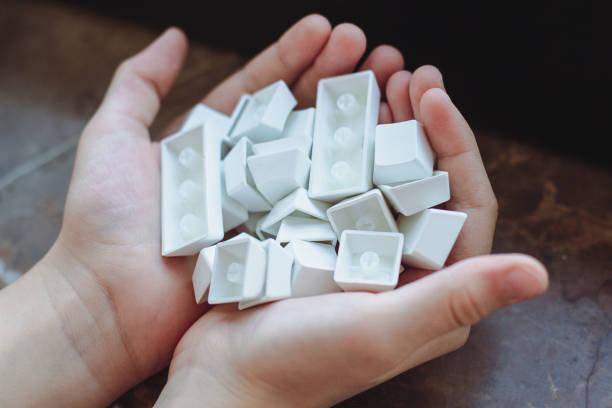Upgrading your mechanical keyboard with a set of high-quality keycaps can completely transform the look, feel, and enjoyment of typing. But with so many styles, materials, profiles, and design options to choose from, it can be tricky knowing what to look for. This guide breaks down the key considerations when shopping for mechanical keyboard keycaps so you can find your perfect match.
Keycap Material
The material used to construct keycaps has significant impacts on durability, texture, sound, and price. Here are some of the most common options:
ABS Plastic – ABS (acrylonitrile butadiene styrene) is the most common and affordable plastic used to make keycaps. It allows for intricate designs and custom colors. But it also wears down over time, developing a shiny texture with extended use.
PBT Plastic – For longer lasting keycaps, PBT keycap is considered superior. It has a textured matte finish that resists wearing down or getting shiny. It’s also more durable overall. But colorful custom designs are less common.
Doubleshot PBT – This manufacturing process combines two layers of PBT plastic for added durability. The inner layer allows bright and vivid colors or clear lettering that won’t fade or rub off.
POM Plastic – POM (polyoxymethylene) plastic has a smooth texture and produces a deeper “thock” sound. It’s not as durable as PBT keycap but more affordable.
Metal – Solid metal keycaps have excellent durability and temperature resistance. The material also changes the acoustics andtyping feel. But they are heavy, expensive, and can impact switch actuation.
Keycap Profile
The profile refers to the exact shape and curvature of the keycaps from top to bottom. The most common options include:
OEM – Based on the original Cherry manufacturer mold, OEM profile is medium height with a flat top and slight curvature. They are widely compatible and a good starter choice.
Cherry – Very similar to OEM with a curved top and cylindrical shape. Cherry profile is just slightly lower overall.
SA – SA keycaps are completely cylindrical with no flat surfaces. They are taller than OEM or Cherry profiles.
DSA – With a very low and uniform profile across the entire keyboard, DSA keycaps have a spherical top and cup-like shape.
XDA – A low-profile between DSA and SA, XDA keycaps have a cropped spherical top and slightly more defined rows.
Make sure to match the keycap profile to your keyboard layout for the proper fit and spacing. Some profiles like SA or high-sculpted designs may not work with north-facing switch keyboards.
Material Compatibility
The type of switch in your mechanical keyboard can impact compatibility with different keycaps. Here are the main factors to check:
Stem Style – Most custom keysets support cross-shaped MX style switch stems from major brands like Cherry or Gateron. Others have proprietary connectors.
North vs South Facing – North facing switches may experience interference issues with extra tall keycaps, requiring low-profile options instead.
LED Cutouts – For keyboards with backlighting or per-key RGB lighting, the keycaps need a translucent notch to allow the light to shine through.
Stabilizer Size – Extra wide keys like space bar, enter, shift, etc need corresponding stabilizer rods and stems underneath.
Row Sizing – Non-uniform, sculpted keycap sets have different profiles for each row that must align properly with your keyboard’s layout.
Legends, Fonts, and Sub-Legends
The symbols, numbers, letters, and characters printed on the keycaps are known as legends. This includes everything from alphanumeric keys to modifiers and novelties. Things to look for include:
Material – Thick dye sublimated or doubleshot plastic legends last longer than cheaper pad printed or laser etched options prone to fading.
Font – Most keysets use simple sans-serif fonts for legibility, but some offer stylized typefaces for custom looks.
Language Support – International or non-English keyboards need special characters, accents and localization.
Sub-Legends – Secondary functions or symbols printed along the bottom or sides of keys. Useful for remembering shortcuts or macros.
Novelty Keys – Unique novelty icons for single keys replace the standard legends with fun symbols, brands, characters, etc.
Backlight Shine-Through – Translucent keycap material and legends which allow keyboard backlighting or RGB lighting to shine through.
Compatibility Considerations
The most important factor is ensuring full compatibility with your specific mechanical keyboard’s layout, size, switch type, and design before purchasing keycaps. Here are common factors to keep in mind:
Layouts – ANSI, ISO, ergonomic, columnar, split, etc. Need to match your exact keyboard size and enter key arrangement.
Size – Measure the exact width for larger keys like spacebar or right shift to match your keyboard.
Switch Style – Keycaps must have the proper Cherry, OEM, Topre, or other style connector stem and fit.
North vs South Facing Switches – Requires low-profile keycaps for north facing boards.
Stabilizers – Keycap inserts must align precisely with built-in mount points for larger keys.
Underglow/RGB – If present, keycaps need translucent areas, interior diffusion channels, or shine through legends.
Mac Compatibility – Mac keyboards often need 1u size modifier keys and Option/Command sub-legends.
Conclusion
With so many amazing keycap sets available from countless designers and brands, it may seem overwhelming to choose at first. But by better understanding these key factors like material, profile, compatibility, legend quality and customization options, you can zero in on the perfect set to give your mechanical keyboards some fresh style and feel great to type on for years to come. Check manufacturer product details, dimensions, and community feedback to ensure a quality set that matches your keyboard setup.
















